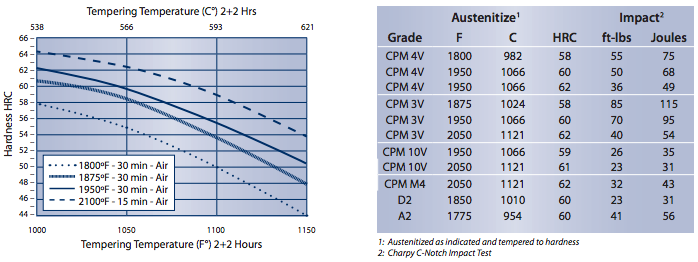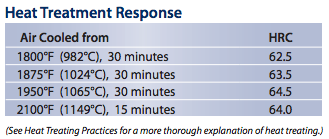CPM 4V Powder Metal Tool Steel
CPM 4V is a powder metal tool steel with an outstanding combination of properties including high impact toughness and very good wear resistance. CPM 4V should be considered for service in fine blanking, powder compaction tools, for processing high-strength low-alloy (HSLA) steels, advanced high-strength steels (AHSS) and applications where a combination of strength, wear resistance and toughness is required.
Applications: CPM 4V should be considered for applications where a higher attainable hardness and additional abrasion resistance is required than can be offered by CPM 3V.
CPM 4V chemistry from Latrobe patent (Koncor) 2,949,356
CPM 4V performance achieved from Crucible patents 3,809,541 (CPM) and 5,830,287 (CPM 3V)
Composition
| C | Mn | Si | Cr | Mo | V |
| 1.35 | 0.40 | 0.80 | 5.0 | 2.95 | 3.85 |
Relative Properties

Physical Properties
- Density: 0.278 lb/in3 (7700 kg/m3)
- Specific Heat: 0.11 Btu/lb/°F (460 J/kg/°C)
- Modulus of Elasticity: 30 x 106 psi (207 GPa)
- Machinability: 50-60% of a 1% carbon steel


Heat Treating Instructions
Hardening
Preheating: 1500-1550°F (816-845°C), equalize.
Austenitizing (High Heat): Heat rapidly from the preheat.
For Maximum Wear Resistance:- Furnace or Salt Bath: 2100°F (1149°C)
- Soak for 15 minutes at temperature
- Furnace or Salt Bath: 1875-1950°F (1024-1065°C)
- Soak for 30 minutes at temperature
- Furnace or Salt Bath: 1800°F (982°C)
- Soak for 30 minutes at temperature
Quenching: Air, pressurized gas, warm oil, or salt.
For pressurized gas, the furnace should have a minimum quench pressure of 4 bars.
For oil, quench until black, about 900°F (482°C), then cool in still air to 150-125°F (66-51°C).
For salt maintained at 1000-1100°F (538-593°C), equalize in the salt, then cool in still air to 150-125°F (66-51°C).
Tempering: Temper immediately after quenching. Typical temperature range is 1000-1100°F (524-593°C). Do not temper below 950°F (510°C). Hold at temperature for 1 hour per inch of thickness, 2 hours minimum, then air cool to ambient temperature. Double tempering is required.
Annealing
Annealing must be performed after hot working and before rehardening.
Heat at a rate not exceeding 400°F per hour (222°C per hour) to 1600-1650°F (871-899°C), and hold at temperature for 1 hour per inch of maximum thickness; 2 hours minimum. Then cool slowly with the furnace at a rate not exceeding 50°F per hour (28°C per hour) to 1000°F (538°C). Continue cooling to ambient temperature in the furnace or in air. The resultant hardness should be approximately 241 HBW.